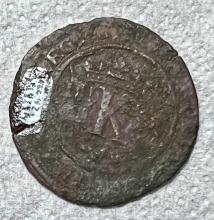chiconpohualli pesos (Chav1)
This series of compound glyphs, each representing twenty pesos, serves as a anotation for 140 pesos (chiconpohualli pesos). It shows five plus two more of these compound signs representing 20 pesos each. Each 20-peso sign is a red crescent with a corn cob inside it, a double logogram. The segmentation into visible kernels is what suggests maize. A vertical red line separates the two groups, five on the left and two on the right. Chicon- is a truncation of the number seven (chicome). Pohualli means one count of twenty.
Stephanie Wood
The reference is to the number of pesos, and corn is not literally present. The association between corn cobs and the number twenty is a cultural one. Twenty is a "full count" in the vigesimal system, and twenty ears of corn was probably a customary grouping.
The line separating five from two twenties is a reminder that the chico- (chicu-, chiuh-) start to numbers larger than five (such as chicome, seven) contains an old root that Richard Andrews calls a "special form of the adverbialized nounstem," referring to "one side."
See some other configurations of groups of pesos below.
Stephanie Wood
chicō poualli.
chiconpohualli
Stephanie Wood
1578
Stephanie Wood
7
números, monedas, pesos, dinero, coins, money, numbers, maize, corn
chiconpohual(li), 7 x 20 = 140, https://nahuatl.wired-humanities.org/content/chiconpohualli
peso, a unit of money, https://nahuatl.wired-humanities.org/content/peso
140 pesos
Stephanie Wood
The Codex Chavero of Huexotzinco (or Códice Chavero de Huexotzinco), https://www.loc.gov/resource/gdcwdl.wdl_03246_001/?sp=1
The Codex Chavero of Huexotzinco (or Códice Chavero de Huexotzinco) is held by the Instituto Nacional de Antropología e Historia, México. It is published online by the World Digital Library and the Library of Congress, which is “unaware of any copyright or other restrictions in the World Digital Library Collection.”




